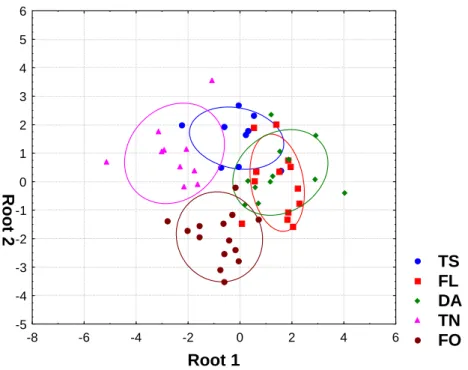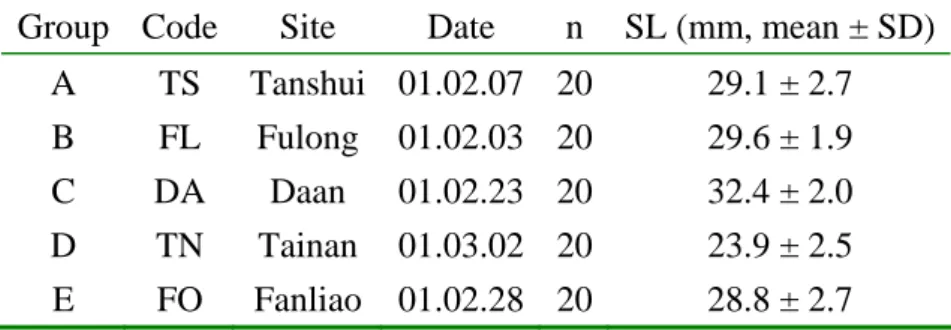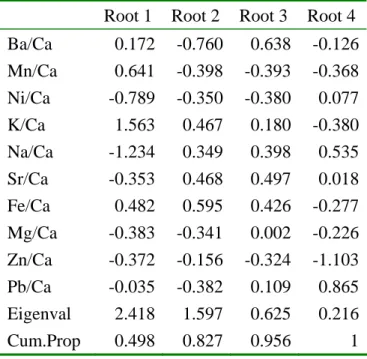行政院國家科學委員會專題研究計畫 期中進度報告
以耳石微量元素及同位素探討烏魚的洄游環境史及系群構
造(1/2)
計畫類別: 個別型計畫 計畫編號: NSC93-2313-B-002-054- 執行期間: 93 年 08 月 01 日至 94 年 07 月 31 日 執行單位: 國立臺灣大學漁業科學研究所 計畫主持人: 曾萬年 計畫參與人員: 王佳惠、張至維、許智傑、游鎮烽 報告類型: 精簡報告 報告附件: 出席國際會議研究心得報告及發表論文 處理方式: 本計畫可公開查詢烏魚耳石微量元素組成的地理差異
本研究利用了耦合電漿質譜儀 (ICP-MS),分析採自台灣五個不同河口的烏 魚苗 (Mugil cephalus) 耳石,以了解其微量元素組成的地理差距。烏魚苗標本是 在 2001 年 2-3 月間分別收集自淡水、台中大安、台南鹿耳門、枋寮以及東北部 的福隆。在所分析的十二種元素中,其中五種元素濃度河口間有顯著差異,分別 是錳、鎳、鋅、鍶以及鋇 (ANOVA, p <0.01) 。進一步的利用多變量分析法中的 判別分析,發現錳、鎳、鋅三種元素與鈣的比值在第一個判別函數上扮演比較重 要的角色 (49.8 %),而鋇與緦鈣比則在第二個判別函數上較為重要 (32.9 %)。結 果發現,根據耳石上十個元素值所產生的此判別模式,有 84 % 的烏魚苗可以正 確的回朔其來源,表示利用分析耳石微量元素組成這樣的自然標誌,可以用來判 別其來源河口的方法之一。Geographic variation of otolith elemental composition in the juvenile
grey mullet (Mugil cephaus) collected from Taiwanese estuaries
The otolith chemical composition of juvenile grey mullet (Mugil cephalus) was analysed by solution-based inductively coupled plasma-mass spectrometry (ICP-MS). The juveniles were collected from 5 different Taiwanese estuaries, including Tanshui (TS), Daan (DA), Tainan (TN), Fonliao (FO) and Fulong (FL) during February to March 2001. Out of twelve elemental concentrations (Li, Na, Mg, K, Mn, Fe, Ni, Cu, Zn, Sr, Ba, and Pb) to calcium molar ratios analyzed, five elements (Mn, Ni, Zn, Sr, and Ba) were found to be significant difference between estuaries (ANOVA, p <0.01). The analysis of forward canonical discriminant function indicated that 10 of 12 elemental ratios (except Li/Ca and Cu/Ca) played significant role on discrimination. Among them, Mn/Ca, Ni/Ca and Zn/Ca contributed approximately 49.8 % in the 1st canonical function of the discrimination, while Ba/Ca and Sr/Ca contributed 32.9 % in the 2nd. As a result, 84 % of the mullet larvae could be assigned to their recruited estuaries with their otolith chemical signatures. These findings indicated that
elemental composition in otolith of the fish can be used as a natural tag to trace their nursery areas.
Introduction
The grey mullet, Mugil cephalus Linnaeus, 1758, is an economically important species for commercial fisheries and aquaculture worldwide (Nash and Shehadeh 1980). The migration of mullet in waters adjacent to Taiwan follows seasonal changes in coastal currents. Mullet of 3-4 yr of age migrate southward with the NE monsoon driven coastal current from the coastal waters of mainland China to the waters off southwestern Taiwan to spawn during the winter (Tung 1981, Chen and Su 1986, Huang and Su 1989). Their eggs and larvae drift with the coastal current from the spawning grounds to estuaries on the western coast of Taiwan where they become juveniles at the age of 1-2 mo post-hatching (Tung 1981, Lee and Kuo 1990, Chang et al. 2000, Chang and Tzeng 2000, Chang et al. 2004a,b). Present study is aim to
examine the differences of the otolith elemental fingerprinting on grey mullet larvae collected from different estuaries, and to test the possibility using the otolith
fingerprints as an indicator to distinguish the recruiting estuaries of the mullet larvae.
Materials and Methods
Otolith preparation and analysis. The juveniles of mullet were collected from 5
different Taiwanese estuaries, including Tanshui (TS), Daan (DA), Tainan (TN), Fonliao (FO) and Fulong (FL) during February to March 2001 (Table 1). After measuring the standard length (SL), the sagittal otoliths were removed, cleaned of adhering tissue, and air-dried. Otoliths were then ultrasonically cleaned in double distilled water; triple rinsed and placed in acid-washed Eppendorf microcentrifuge tubes to dry. After drying, otoliths were individually weighed on a microbalance to the nearest 10 µg and transferred to acid-washed 1.5 mL high-density polyethylene vials and dissolved in 0.3 N ultrapure nitric acid. A lab standard, consisting of otolith matrix-matched chemical composition with interested elements were analyzed during each session of analysis. Lab standard solution was prepared at a serious
concentration with Ca at 0.5, 1, 2.5, 5 and 10 ppm for calibration. Extra amount of 2.5 ppm Ca were prepared and that were analysed every 10 samples to monitor instrument drift. All analyses were run on a FinniganTM Element 2 high-resolution ICP-MS. Preliminary analyses suggested that 13 elements, including Li, Na, Mg, K, Ca, Mn, Fe, Ni, Cu, Zn, Sr, Ba, Pb, were detectable in otoliths using ICP-MS and these elements were chosen for analyses.
differences of the otolith elemental signature among sites. We also used discriminant function analyses to determine how accurately we could classify elvers to their recruit estuaries. A stepwise discriminant function analysis was performed, and a jackknife cross-validation was calculated consequently to determine how accurately otolith elemental signature could distinguish mullet larvae from the different recruit estuaries. All statistic analyses were preformed using STATISTICA© (Version 6.0, StatSoft Inc.) software programs.
Results
Twelve elemental concentrations (Li, Na, Mg, K, Mn, Fe, Ni, Cu, Zn, Sr, Ba, and Pb) to calcium molar ratios in otolith of the mullet were analyzed and five elements (Mn, Ni, Zn, Sr, and Ba) were found to be significant difference among estuaries (ANOVA, p <0.01) (Table 2). The analysis of forward canonical discriminant function indicated that 10 of 12 elemental ratios (except Li/Ca and Cu/Ca) played significant role on the discrimination of the mullet among estuaries (Table 3. and Fig. 1). Among them, Mn/Ca, Ni/Ca and Zn/Ca contributed approximately 49.8 % in the 1st canonical function of the discrimination, while Ba/Ca and Sr/Ca contributed 32.9 % in the 2nd function (Table 3). The result shows that 84 % of the mullet larvae could be assigned to their recruited estuaries by the otolith chemical signatures (Table 4).
Conclusion
Elemental composition in otolith of the fish is a useful natural tag for trace their nursery areas of mullet. Future work will analysis the otolith composition of adult migratory mullet and combine current result for estimating the contribution of each Taiwan nursery estuaries to the migratory mullet population.
研究成果自評 本計劃執行至今,與原計畫預定進度相符合,另外我們也已經收集了去年冬天洄 游群的烏魚成魚標本,下一年度將進行這些耳石的分析,以期進一步了解烏魚洄 游生態及不同河口對其產卵族群的貢獻量。今年度的研究結果以經於 2005 年 5 月在台北舉行的印度太平洋國際魚類研討會中發表,預計近期內會投至國際期刊 審查。 References
Chang CW, WN Tzeng. 2000. Species composition and seasonal occurrence of mullets (Pisces, Mugilidae) in the Tanshui estuary northwest Taiwan. J. Fish. Soc. Taiwan 27: 253-262.
Chang CW, WN Tzeng, YC Lee. 2000. Recruitment and hatching dates of grey mullet (Mugil cephalus L.) juveniles in the Tanshui estuary of northwest Taiwan. Zool. Stud. 39: 99-106.
Chang CW, Iizuka Y, Tzeng WN (2004a) Migratory environmental history of the grey mullet Mugil
cephalus as revealed by otolith Sr:Ca ratios. Mar. Ecol. Prog. Ser. 269: 277-288.
Chang CW, Lin SH, Iizuka Y, Tzeng WN (2004b) Relationship between Sr:Ca ratios in otoliths of grey mullet Mugil cephalus and ambient salinity: validation, mechanisms, and applications. Zool. Stud.
43: 74-85.
Chen WY, WC Su. 1986. Reproductive biology of the grey mullets, Mugil cephalus L. of Taiwan. In WC Su, ed. Study on the resource of grey mullet in Taiwan, 1983-1985. Kaohsiung: Kaohsiung Branch TFRI, pp. 73-80.
Huang CS, WC Su. 1989. Studies on the fluctuations of fishing conditions for grey mullet (Mugil
cephalus Linnaeus) from the western coast of Taiwan. J. Fish. Soc. Taiwan 16: 47-83.
Lee CY, CL Kuo. 1990. Kinds, local names and seasonal appearance of the fingerlings of grey mullet,
Mugil cephalus L., in coastal waters of west Taiwan. China Fish. Mon. 448: 13-18.
Nash EC, ZH Shehadeh. 1980. Review of breeding and propagation techniques for grey mullet, Mugil
cephalus L. ICLARM Stud. Rev. 3: 1-40.
Tung IH. 1981. On the fishery biology of gray mullet, Mugil cephalus L., in Taiwan. Rep. Inst. Fish. Biol. Ministry Econ. Affairs Natl. Taiwan Univ. 3: 38-102.
Fig. 1. Canonical discriminant plot (functions 1 & 2) of 10 elements:Ca concentration TS FL DA TN FO -8 -6 -4 -2 0 2 4 6 Root 1 -5 -4 -3 -2 -1 0 1 2 3 4 5 6 Root 2
Table 1. Sampling details with sampling river sites, collecting dates, and the average
standard length of the larvae (mean ± SD, in mm).
Group Code Site Date n SL (mm, mean ± SD)
A TS Tanshui 01.02.07 20 29.1 ± 2.7
B FL Fulong 01.02.03 20 29.6 ± 1.9
C DA Daan 01.02.23 20 32.4 ± 2.0
D TN Tainan 01.03.02 20 23.9 ± 2.5
E FO Fanliao 01.02.28 20 28.8 ± 2.7
Table 2. Mean concentration to Ca ratio on mullet larvae otolith, and the results of
ANOVA and homogenous group test comparing the difference between sampling
estuaries.
mmol/mol N Mean SE F p HG (Tukey Test)
Li/Ca 77 8.0×10-6 2.9×10-7 0.562 0.691 Na/Ca 75 1.4×10-2 1.1×10-4 3.098 0.021 Mg/Ca 73 5.9×10-4 2.2×10-5 2.161 0.083 K/Ca 74 1.6×10-3 3.1×10-5 1.609 0.182 Mn/Ca 77 5.0×10-6 1.9×10-7 6.438 <0.001 TN=TS=FO≦DA=FL Fe/Ca 75 1.2×10-5 6.1×10-7 0.993 0.417 Ni/Ca 76 5.0×10-6 4.1×10-7 6.473 <0.001 DA=FL=TS≦FO≦TN Cu/Ca 75 7.0×10-6 5.8×10-7 2.717 0.037 Zn/Ca 72 3.8×10-5 4.6×10-6 6.978 <0.001 DA=TS=FO=FL≦TN Sr/Ca 77 2.9×10-3 2.2×10-5 4.389 0.003 DA=FO≦FL=TN=TS Ba/Ca 74 4.0×10-6 1.9×10-7 15.160 <0.001 TN=DA<TS=FL=FO Pb/Ca 75 1.0×10-6 9.8×10-8 0.923 0.455
Table 3. Standardized canonical discriminant function coefficients from the
microelement analysis of otoliths from mullet larvae.
Root 1 Root 2 Root 3 Root 4
Ba/Ca 0.172 -0.760 0.638 -0.126 Mn/Ca 0.641 -0.398 -0.393 -0.368 Ni/Ca -0.789 -0.350 -0.380 0.077 K/Ca 1.563 0.467 0.180 -0.380 Na/Ca -1.234 0.349 0.398 0.535 Sr/Ca -0.353 0.468 0.497 0.018 Fe/Ca 0.482 0.595 0.426 -0.277 Mg/Ca -0.383 -0.341 0.002 -0.226 Zn/Ca -0.372 -0.156 -0.324 -1.103 Pb/Ca -0.035 -0.382 0.109 0.865 Eigenval 2.418 1.597 0.625 0.216 Cum.Prop 0.498 0.827 0.956 1
Table 4. Classification matrix results of the multiple elements :Ca ratios in otoliths of
mullet larvae. Correct % TS FL DA TN FO TS 77.8 7 1 1 0 0 FL 69.2 1 9 2 0 1 DA 83.3 0 2 10 0 0 TN 100.0 0 0 0 10 0 FO 92.9 0 1 0 0 13 Total 84.5 8 13 13 10 14


